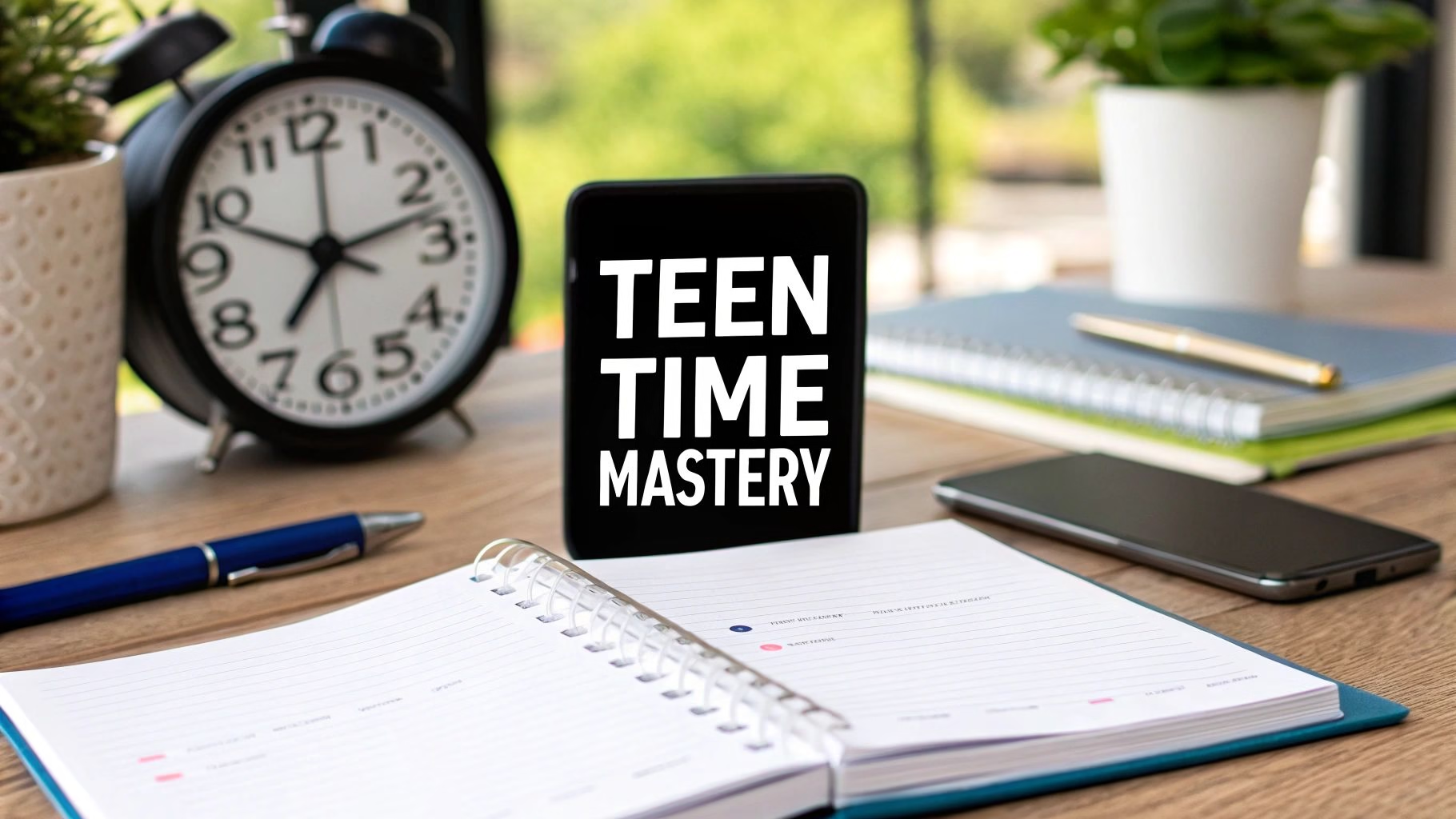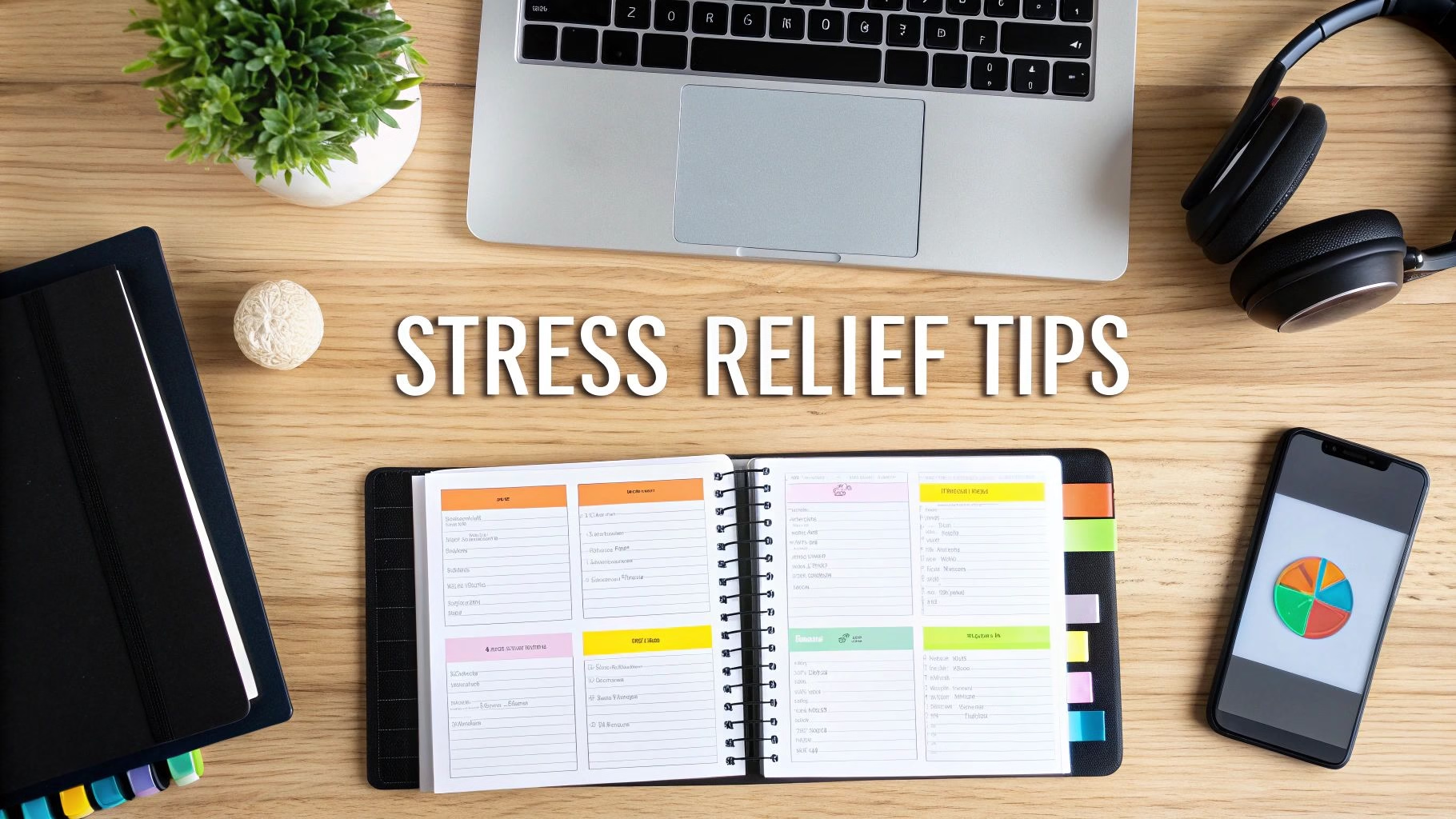When you think about "goal setting," you might picture corporate strategies or New Year's resolutions. But when it comes to teenagers, it’s a whole different ball game. It’s not about us adults pushing our own ambitions onto them. It's about guiding them to discover their own reasons to try, to build a sense of purpose that comes from within.
This one skill can have a ripple effect, touching everything from how they do in school to their mental health for years to come.
Why Goal Setting Is a Vital Skill for Your Teen

The teenage years can feel like a storm of social pressures, academic demands, and figuring out who you are. Giving a teen a framework for setting goals is like handing them a compass in the middle of that storm. It won’t tell them where to go, but it gives them a powerful tool to navigate their own path with confidence.
This is where the process has to be different from how we, as adults, might set goals. With teens, the dynamic has to shift from control to collaboration. The real aim is to help them draw a line between their day-to-day actions—like studying for that dreaded math test or saving up their allowance—and a bigger, more meaningful vision they've created for themselves.
Building Motivation and Beating Procrastination
One of the biggest frustrations I hear from parents is watching their teen procrastinate, especially with schoolwork. But here's the thing: it's rarely about laziness. More often than not, it's a symptom of feeling totally overwhelmed or just not seeing the point. Goal setting is the bridge over that gap.
When a teen sets a goal they actually care about—whether it’s finally acing a class they love or saving up for their driver's license—their own internal motivation starts to fire up. The work transforms from a boring chore into a necessary step toward something they want.
- It creates a "why." Goals give teens a real reason behind all their hard work.
- It shrinks the overwhelm. Breaking a huge goal into smaller, bite-sized pieces makes it feel way less intimidating.
- It builds self-accountability. When they have a clear target, they can track their own progress. Suddenly, you don't have to be the one constantly reminding them.
Supporting Mental Health and Well-Being
The connection between having a sense of direction and good mental health is undeniable. When teenagers feel like they're just drifting, they're far more vulnerable to anxiety and a nosedive in self-esteem. Having goals provides a structure that can be incredibly grounding.
The very act of setting a goal and chipping away at it builds resilience. It teaches teens a fundamental truth: they can overcome challenges, and their effort produces real results. That's a massive confidence booster.
This isn’t just a nice idea; the research is solid. A massive 17-year longitudinal study revealed that the goals adolescents set for themselves are a powerful predictor of their well-being and psychological health way into adulthood. By teaching this skill now, you’re giving them a foundation for a happier, more fulfilling life. You can dig into the complete study on adolescent goals and adult well-being to see the data for yourself.
How to Discover Your Teen's True Motivations

Real goal setting for teenagers isn't about giving them a checklist. It’s about digging deeper to find out what actually drives them. The goals that stick are the ones built on their own genuine interest, not on pressure from parents or teachers.
To get there, you have to become a trusted partner in their journey of self-discovery. That all starts with having open, judgment-free conversations.
This means you need to set aside your own expectations for a bit and just listen. Genuinely listen. Pay attention to their passions, their fears, and even the dreams that sound a little out there. When a teen feels like you’re actually hearing them out, they’re much more likely to buy into the whole idea of setting goals for themselves. It’s about helping them figure out their "why" before you even get to the "how."
Starting the Conversation Without Pressure
The trick here is to avoid making it feel like an interrogation about their future. Instead, try weaving it into your everyday routine. A casual chat in the car or while you’re making dinner often works way better than a scheduled, sit-down meeting, which can feel way too intense.
Parenting Tip: Create a safe space where they feel comfortable spitballing ideas without worrying about being shot down. If their dream is to be a professional gamer or a TikTok star, try to resist the urge to immediately bring up the odds. Get curious instead. Ask what they love about it. This simple act validates what they care about and opens the door to a real conversation.
The best talks are usually sparked by curiosity, not a direct question like, "So, what are your goals?" Try something like, "If you could do anything you wanted this Saturday, what would it be?" or "What's something you've seen someone else do that you thought was really cool?" This approach builds trust and helps you see the underlying themes in what motivates them. Maybe it's the creativity of gaming that pulls them in, or the community, or the technical skill behind it all. Those are the threads you can use to help them build tangible goals.
Connecting Interests to Action and Well-Being
Once you have an idea of what they’re into, you can help them connect those passions to small, concrete steps. This is a game-changer for tackling procrastination, which often comes from feeling overwhelmed or just completely disconnected from schoolwork. When a teen sees how getting a handle on algebra could help them design a better game level, the motivation shifts from an external demand to an internal drive.
That sense of purpose is also deeply tied to their mental health. Sometimes, a lack of motivation or constant procrastination can be a sign of something bigger, like anxiety or depression. Research shows that teens who feel a sense of control over their lives report higher levels of well-being.
- Validate their feelings. It’s normal to feel lost or unmotivated. Saying something like, "It sounds like you're feeling really stuck right now," can make a world of difference.
- Normalize asking for help. If you see them disengaging for a while or notice other signs of distress, it's okay to start a conversation about mental health. Organizations like the National Alliance on Mental Illness (NAMI) and The Jed Foundation have great resources and support for teens.
- Focus on small wins. Help them pick one tiny, achievable step they can take toward something that interests them. If you're looking for more strategies, exploring expert advice on how to motivate a teenager can offer practical ways to help them get moving again.
When you act as a supportive guide instead of a director, you empower your teen to build goals that are not just achievable but truly their own. This process builds confidence, resilience, and a life skill that will serve them long after they've left home.
Turning Ambitions into Actionable Plans
An idea without a plan is just a wish. That’s a hard lesson, but a crucial one, especially when it comes to goal setting for teenagers. They often have huge dreams but get completely overwhelmed trying to figure out how to make them real.
This is where you can step in—not as a manager with a clipboard, but as a supportive coach. The real secret is helping them translate those big ambitions into concrete, actionable plans using a framework that actually works.
We’ll adapt the classic SMART goal system for the unique mindset of a teenager. Forget the corporate jargon. We’re applying it to things they actually care about, like acing a history final, saving up for concert tickets, or making the varsity soccer team.
Making Goals Specific and Clear
Vague goals like “do better in school” are impossible to act on. They’re a recipe for procrastination. The very first step is to help your teen get laser-focused.
If the goal is academic, which subject? What specific grade are they aiming for? If it's about saving money, how much, and what for? A specific goal gives them a clear target to aim at.
Instead of "get better at math," it becomes "understand quadratic equations well enough to get a B+ on the next test." That clarity immediately makes the goal feel more real and a lot less intimidating. It’s the difference between wandering around aimlessly and having a destination plugged into your GPS.
The image below shows just how important it is to track these specific steps. This is the core of turning a fuzzy wish into a tangible plan.

This visual really drives home how digital tools can help teens watch their own progress, making the journey feel more like leveling up in a game instead of some endless, boring chore.
Building a Plan They Can Actually Follow
Once the goal is specific, the rest of the framework falls into place. This is where motivation meets practical, real-world planning. We need to make the goal measurable, achievable, relevant, and time-bound.
- Measurable: How will they know they're making progress? For a grade goal, maybe it's completing five practice problems a day. For saving money, it’s tracking every dollar that comes in and goes out.
- Achievable: The goal needs to be a stretch, but not a fantasy. Trying to jump from a D to an A in one week is a setup for burnout. A much better goal is aiming to raise the grade to a C+ on the next quiz. Small wins build momentum.
- Relevant: This one is everything. The goal has to matter to them. If your teen doesn't see the point, their motivation will vanish. It must connect to their own wants and values, not just yours.
- Time-bound: A deadline creates a healthy sense of urgency. "I'll save $200" is a wish. "I'll save $200 by July 1st by setting aside $25 from my paycheck each week" is a plan.
A huge challenge for teens is that a lack of clear, manageable goals can crank up their anxiety. When goals feel too big or undefined, it can lead to a nasty cycle of procrastination and low self-esteem. Breaking goals down makes them approachable and gives teens a sense of control, which is vital for their mental health.
If you think your teen's procrastination might be tied to deeper issues like anxiety, getting professional guidance can make all the difference. Trusted resources like the National Alliance on Mental Illness (NAMI) and The Jed Foundation offer amazing support and information for teens and their families.
From Vague Wishes to SMART Goals
Let's see what this looks like in the real world. So many teens have brilliant ideas but get stuck on the follow-through. The table below shows exactly how to transform those common teenage daydreams into powerful, structured goals they can actually hit.
| Vague Wish | SMART Goal Breakdown |
|---|---|
| "I want to be better at art." | Specific: I want to improve my digital drawing skills, focusing on character design. Measurable: I will complete one new character sketch every week. Achievable: I will watch one 20-minute tutorial on YouTube twice a week and practice the techniques. Relevant: This will help me build a portfolio for a summer art program I'm interested in. Time-bound: I will have a portfolio of 10 finished character designs in 10 weeks. |
| "I need to pass my driving test." | Specific: I will pass my behind-the-wheel driving test on the first try. Measurable: I will log 10 hours of practice driving this month, focusing on parallel parking and lane changes. Achievable: I will schedule two 1-hour practice sessions with a parent each week. Relevant: Getting my license will give me more independence and allow me to get to my part-time job on my own. Time-bound: I will be ready to take my test in 6 weeks, on my scheduled appointment date. |
When you guide your teen through this process, you’re teaching them so much more than how to check a box. You’re giving them a lifelong tool for turning their biggest dreams into reality, building their confidence and resilience with every single step they take.
Conquering Procrastination and School Stress
Even the best-laid plans can get derailed by two huge obstacles: procrastination and stress. For teenagers, the pressure from school can feel like a constant weight. Juggling assignments, looming exams, and mapping out the future is a lot, and it often leads to a cycle of avoidance that leaves parents feeling confused and frustrated.
But here’s the thing: procrastination is rarely about being lazy. It's an emotional reaction. Think of it as a defense mechanism against the fear of failure or that paralyzing feeling of being completely overwhelmed by a task that seems way too big to tackle. To be effective, any goal-setting system for teens has to face this head-on with real tools to manage those feelings.
Getting to the Root of Procrastination
When your teen puts off studying for a big test, it’s probably not because they don't care. The real reason might be a deep-seated fear that even if they pour their heart into it, they’ll still fall short. For other teens, a huge project with a deadline weeks away feels so massive they don't even know where to start.
This is exactly where a well-structured goal becomes a secret weapon against procrastination. When you break a huge goal into smaller, bite-sized steps, the overwhelm just shrinks. The focus shifts from something terrifying like "write a 10-page history paper" to a much more manageable task, like "find five credible sources by Tuesday." This is a game-changer when learning how to stop procrastinating, because it turns an intimidating mountain into a series of small, climbable hills.
Practical Ways to Get Motivated and Take Action
To break free from that cycle of avoidance, teens need a toolkit of strategies that actually work for their brain and their life. These aren't just theories; they're proven methods for creating structure and building momentum, making it way easier to just get started.
- Task-Batching: This is all about grouping similar small tasks together. For instance, instead of answering emails and texts as they pop up, your teen could set aside a 20-minute block to clear their inbox. It cuts down on the mental clutter and makes it easier to focus.
- The Pomodoro Technique: A super popular time-management method. You work in focused 25-minute sprints, separated by short breaks. It makes long study sessions feel less daunting and helps keep energy levels high, preventing that late-night burnout.
- Create a Distraction-Free Zone: Help your teen design a workspace that sends a clear signal to their brain: "it's time to focus." This might mean putting their phone in another room, using an app to block distracting websites, or just getting all their books and notes ready before they sit down.
Parenting Tip: The magic behind these methods is that they lower the barrier to starting. The hardest part of any task is just beginning. By helping your teen make that first step incredibly small and easy, you help them push past that initial resistance and build some positive momentum.
Building Motivation That Actually Lasts
As a parent, it's so tempting to rely on external rewards—cash for good grades, more screen time for finished homework. This is called extrinsic motivation, and while it might get you results in the short term, it's not a sustainable fix. True, lasting drive has to come from within.
Intrinsic motivation is that fire you get when you do something because it’s genuinely interesting, challenging, or satisfying on its own. You can help your teen tap into this by connecting their schoolwork to what they already care about.
- Do they love video games? Show them how math and physics are the building blocks of game design.
- Do they dream of traveling the world? Suddenly, learning a new language or studying world history has a very real purpose.
This simple shift helps them see school not just as a chore, but as a tool they can use to build the life they actually want.
School goals are a massive part of a teen's world. A Pew Research Center study found that 53% of U.S. teens plan to attend a four-year college, which shows just how much school shapes their vision for the future. But these goals are often influenced by outside pressures, making that internal drive even more critical for overcoming inevitable hurdles. You can discover more insights about how teens view their future goals at pewresearch.org.
Ultimately, beating school stress and procrastination is about empowerment. When teens feel like they have the right tools to manage their work and a real reason to do it, they build a kind of confidence and resilience that goes far beyond the classroom. It doesn't just improve their grades; it supports their mental health and well-being for years to come.
Learning from Setbacks and Tracking Progress
Okay, so you've helped your teen map out a goal. The plan is made. Now what?
Honestly, this is where the real work begins. The journey toward any meaningful goal is never a straight line. It’s more of a marathon filled with small wins, frustrating plateaus, and, yes, a few face-plant moments. This follow-through phase is where true resilience is built.
A huge part of this process is learning how to handle the inevitable stumbles. When your teen misses a milestone or fails to hit their target, it's a prime opportunity for you to step in as a supportive coach, not a critic. The key is to frame these moments not as disasters, but as valuable data points—chances to learn, adjust, and try again.
Finding the Right Way to Track Progress
Every teen is different, so a one-size-fits-all approach to tracking progress just won't cut it. Some live on their phones, while others need something more tangible and visual. The best method is whichever one your teen will actually use consistently.
- For the Digital Native: Apps like Trello, Todoist, or even a simple shared Google Calendar can be great for tracking tasks and deadlines. There's something weirdly satisfying about checking that digital box.
- For the Visual Thinker: A big wall calendar with milestones marked, a visual progress chart (like those fundraising thermometers), or a "goal ladder" where each rung represents a completed step can make progress feel more concrete and real.
- For the Reflective Journaler: A dedicated notebook allows them to not just track what they did, but also to reflect on what’s working, what isn’t, and how they’re feeling about the whole thing.
It’s interesting to see what teens actually prefer. In one survey, while 16% used their phones to track goals, a much larger 48% stuck with traditional notebooks or journals. It goes to show that for many, the physical act of writing things down still holds a lot of power. You can see more teen goal-setting stats from StageofLife.com to get a feel for the trends.
Your Role When They Stumble
Failure is a tough but necessary teacher. Research shows that while most teens set goals, a staggering 81% report having failed to achieve an important one. Your reaction in these moments can shape your teen's relationship with ambition and hard work for years to come.
When a setback happens, resist the urge to jump in with solutions or show disappointment. Instead, create a safe space for them to process what happened. Ask open-ended, non-judgmental questions.
Parenting Tip: Try asking something like, "That sounds really frustrating. What do you think was the biggest challenge?" or "If you were to do it all over again, is there anything you'd do differently?" This shifts the focus from the sting of failure to the power of learning from it.
This approach helps them develop a growth mindset—the belief that their abilities can be developed through dedication and hard work. It's a critical tool for building resilience and is fundamental to their long-term mental health. A teen who isn't afraid to fail is a teen who isn't afraid to aim high.
Building Resilience and Supporting Their Mental Health
The ability to bounce back from disappointment is a cornerstone of good mental health. When teens see setbacks as learning opportunities, it strips failure of its power to cause anxiety and crush their self-esteem. They learn that their worth isn't tied to a perfect track record, but to their willingness to get back up and try again.
Don't forget to celebrate the small victories along the way. This is vital for keeping motivation high. Did they study for 30 minutes like they planned? Acknowledge it. Did they finally nail that tricky chord progression on the guitar? Celebrate it. These small acknowledgements build momentum and keep the process from feeling like a relentless grind.
If you notice that setbacks are consistently leading to significant emotional distress, disengagement, or symptoms of anxiety, it’s important to offer support. Normalizing conversations about mental well-being is key. Resources like the National Alliance on Mental Illness (NAMI) and The Jed Foundation provide excellent information and support networks for teens and their families.
Ultimately, teaching teens how to handle the ups and downs of pursuing a goal is just as important as helping them set it. By learning to redefine failure from a teen's perspective on growth and motivation, they gain a skill that will serve them in every aspect of their lives, from school to careers and beyond.
Your Questions on Teen Goal Setting Answered
Trying to help your teen set goals can bring up a lot of questions. It's a delicate balance. You want to be their guide, but not their manager. You want to offer advice that actually helps, not advice that gets an eye-roll.
I get it. I've worked with countless parents navigating this exact territory. From dealing with a teen who seems totally unmotivated to a teen with dreams so big they feel impossible, here are some of the most common hurdles and how you can approach them like a supportive coach.
What If My Teen Seems Completely Unmotivated?
This is probably the most common—and frustrating—challenge I hear from parents. When a teen has zero goals and even less drive, our first instinct is to push. But as you've likely discovered, that almost always backfires.
Instead of talking about "goals," try shifting the conversation to "interests." What are they curious about? What do they think is cool online? What’s something they enjoy doing, even if it seems unproductive to you? True, lasting motivation almost always starts from a spark of genuine interest, not from a parent's lecture.
Parenting Tip: Become a detective of their interests, not a director of their life. If you see signs of persistent low motivation or withdrawal, be gentle and curious. Ask, "I've noticed you seem down lately, is everything okay?" This opens a door to talk about potential mental health struggles, which can often look like a lack of motivation.
Sometimes, a persistent lack of motivation can be a sign of something deeper. Feeling overwhelmed by school, social anxiety, or other mental health challenges can easily be mistaken for apathy. It’s critical to keep the lines of communication open and judgment-free. If the disinterest is severe or comes with other changes in their behavior, it might be time to bring in a professional.
If you need guidance, great resources are out there. Organizations like The Jed Foundation and the National Alliance on Mental Illness (NAMI) offer fantastic information and support specifically for teens. Your school counselor is also a great place to start.
How Can I Support Them Without Micromanaging?
It’s a fine line between being a supportive parent and becoming your teen's project manager. To stay on the right side of it, think of yourself as a consultant, not the boss. You’re there to offer tools, share your perspective, and be their biggest fan—not to track every single move.
The easiest way to do this is to start asking guiding questions instead of demanding ones. For instance, swap "Did you finish your homework yet?" for something like, "What's your plan for getting your homework done tonight?" It’s a small tweak, but it shifts the ownership from you to them.
Here are a few other ways to support their independence:
- Set up check-ins: Agree on a time to connect about their goals, maybe once a week over pizza. It keeps you in the loop while respecting their space.
- Ask "how," not "if": Questions like, "That sounds tough. How can I help?" show that you believe in them while still offering practical support.
- Let them own the outcome: This is a tough one. But allowing them to experience both the pride of achieving a goal and the natural sting of falling short is how they truly learn accountability.
What If Their Goals Seem Unrealistic?
So your teen announces they want to become a world-famous YouTuber or a pro gamer overnight. Your first instinct might be to list all the reasons that’s a long shot. Resist that urge. Dismissing their dreams is the fastest way to get them to stop sharing things with you.
Instead, see this as the perfect coaching opportunity. This is where you teach them how to build a realistic plan.
Start by validating the dream. Say something like, "That's an awesome goal! What's one small thing you could do this month to get started?"
For that aspiring YouTuber, a great first step isn't fame; it's planning and recording one high-quality video. This approach is powerful because it does two things:
- It shows them you take their passions seriously.
- It teaches them the invaluable skill of breaking a massive dream into small, manageable steps.
This process is what prevents the burnout that comes from chasing a huge goal with no road map. By focusing on that first step, you’re empowering them to start their journey with a win.
At Andrew Petrillo Life Coaching, we specialize in helping teens and young adults navigate these exact challenges. If your teen is struggling with motivation, procrastination, or finding their direction, a personalized coaching plan can make all the difference. We provide the tools and support to turn overwhelm into action and ambition into achievement. Learn more about my approach and book a complimentary discovery call.




















